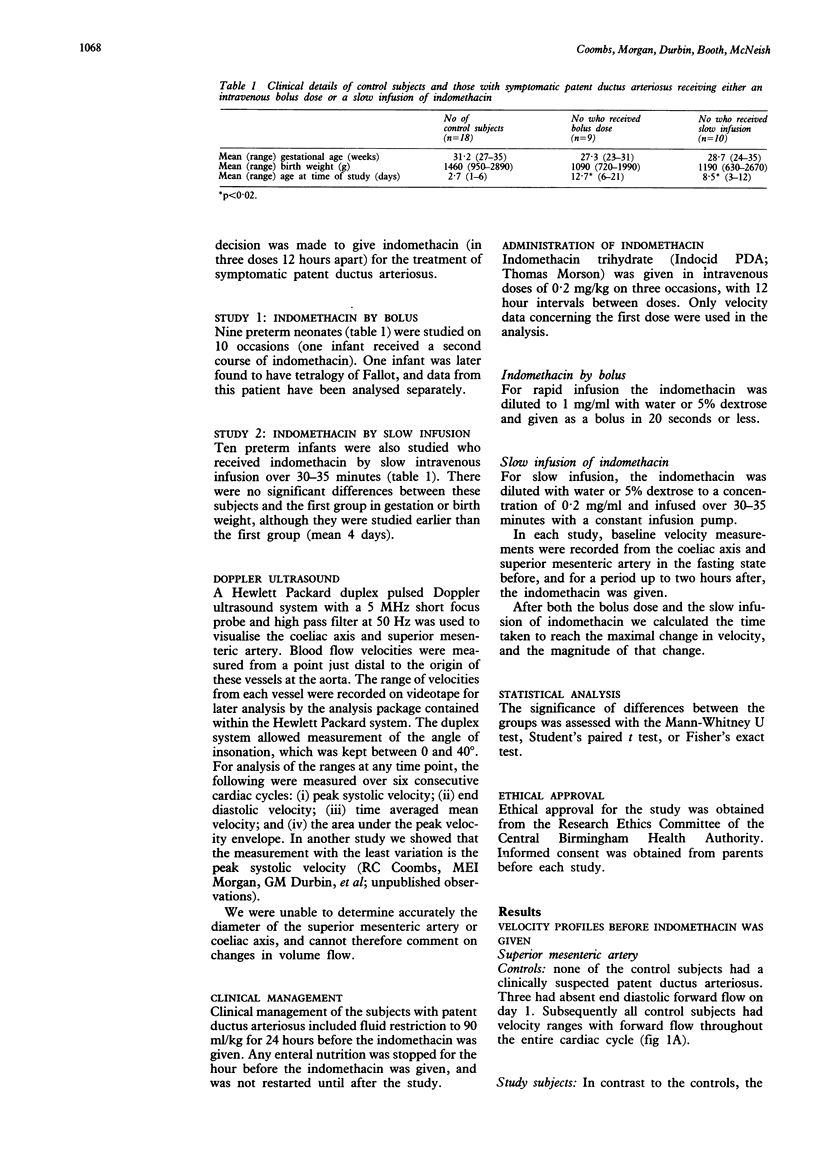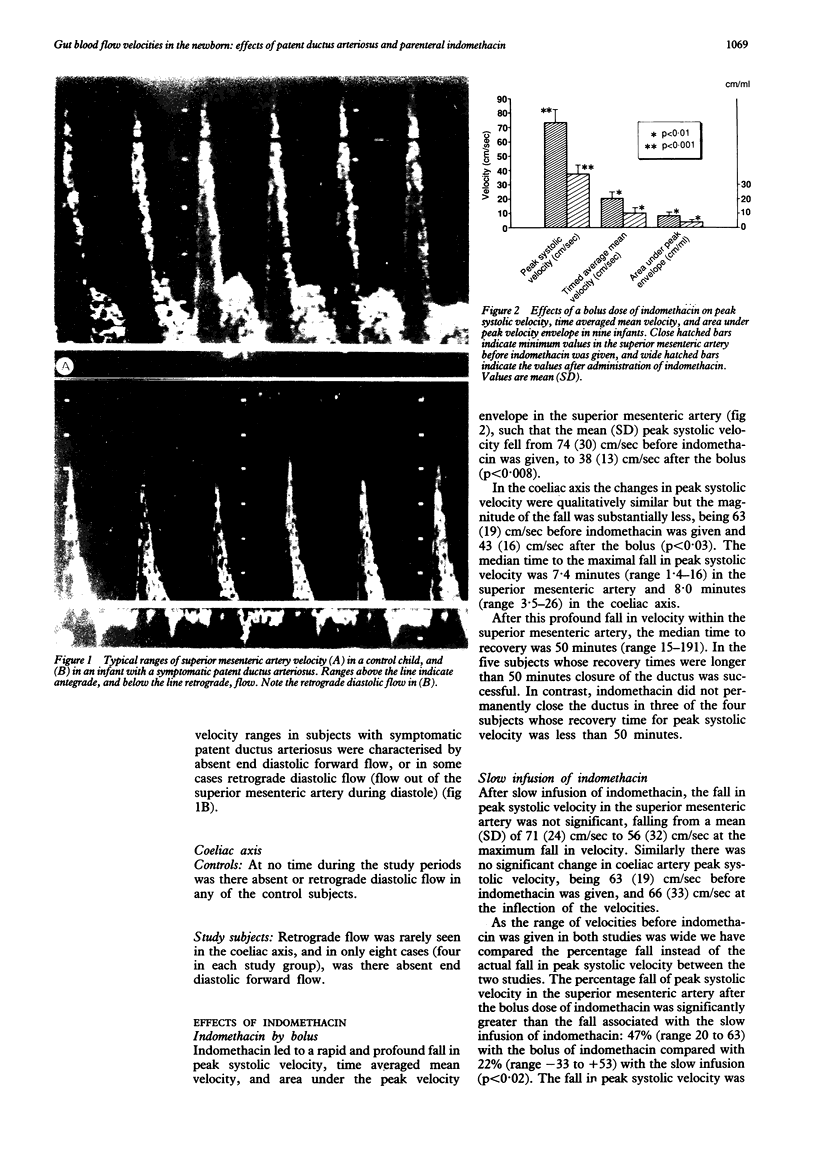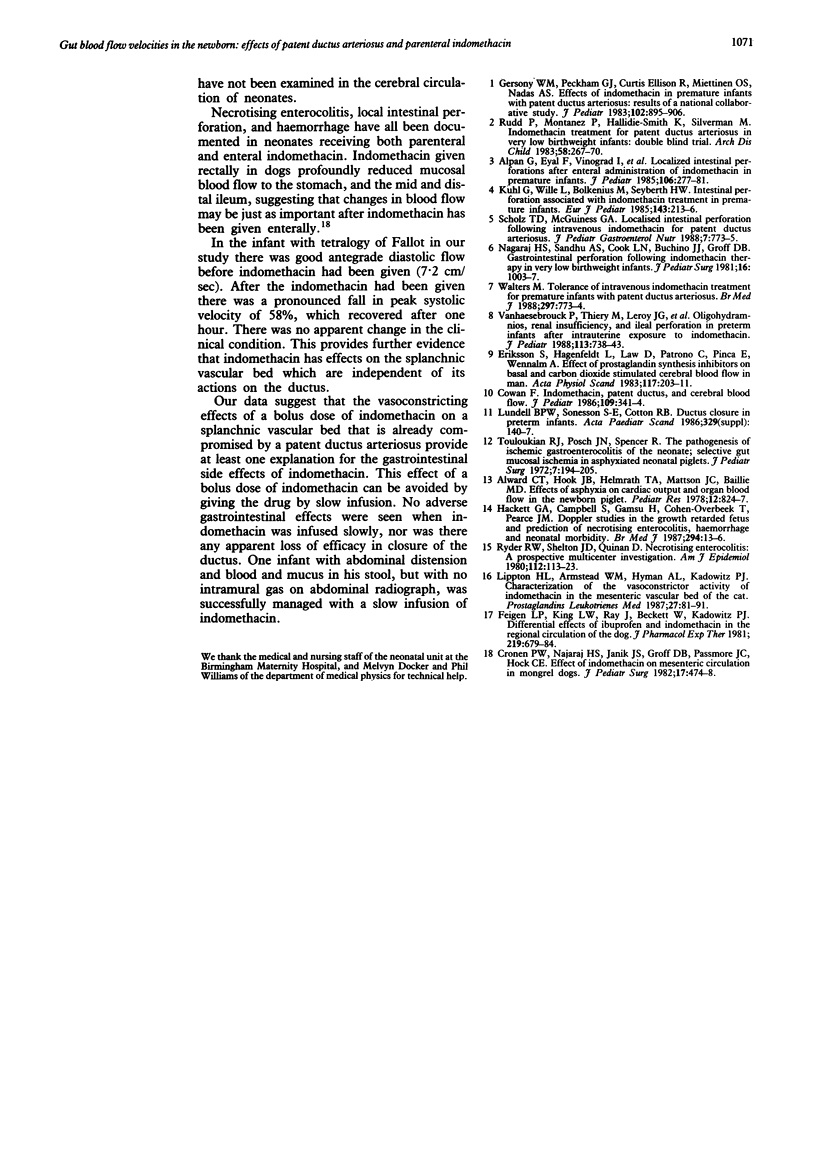Abstract
The effects on gut blood flow velocities of parenteral indomethacin (0.2 mg/kg) given either quickly as a bolus or slowly as an infusion were compared in consecutive studies of two groups of infants with symptomatic patent ductus arteriosus. In the presence of patent ductus arteriosus the range of velocities in the superior mesenteric artery before indomethacin was given was characterised by pronounced abnormalities including absent--or in some cases even retrograde--diastolic flow. In eight subjects the first rapidly given bolus dose of indomethacin (duration 20 seconds or less) caused a pronounced and sustained fall in the velocity of the superior mesenteric artery blood flow (mean peak systolic velocity (cm/second): before 74; after 38; median time to maximum fall 7.4 minutes; median time to recovery 50 minutes). A further 10 subjects received their first dose of indomethacin by slow infusion (duration 30-35 min) and the percentage fall in peak systolic velocity was both substantially less (22% compared with 47%) and later (median time to maximum fall 37.3 minutes) than after rapid infusion. Qualitatively similar but smaller changes were seen in the coeliac axis. Return of antegrade end diastolic flow in the superior mesenteric artery within one hour of the first dose of indomethacin was a good predictor of subsequent closure of the ductus. These data suggest that there is a profound disturbance in mid gut perfusion in infants with patent ductus, which is exacerbated by indomethacin given rapidly by intravenous bolus. They may also provide a rational explanation for the well recognised association between necrotising enterocolitis and both patent ductus arteriosus and indomethacin administration. The unwanted effects of the indomethacin are abrogated by slow infusion, without loss of efficacy in closure of the ductus.
Full text
PDF




Images in this article
Selected References
These references are in PubMed. This may not be the complete list of references from this article.
- Alpan G., Eyal F., Vinograd I., Udassin R., Amir G., Mogle P., Glick B. Localized intestinal perforations after enteral administration of indomethacin in premature infants. J Pediatr. 1985 Feb;106(2):277–281. doi: 10.1016/s0022-3476(85)80305-x. [DOI] [PubMed] [Google Scholar]
- Alward C. T., Hook J. B., Helmrath T. A., Mattson J. C., Bailie M. D. Effects of asphyxia on cardiac output and organ blood flow in the newborn piglet. Pediatr Res. 1978 Aug;12(8):824–827. doi: 10.1203/00006450-197808000-00003. [DOI] [PubMed] [Google Scholar]
- Cowan F. Indomethacin, patent ductus arteriosus, and cerebral blood flow. J Pediatr. 1986 Aug;109(2):341–344. doi: 10.1016/s0022-3476(86)80398-5. [DOI] [PubMed] [Google Scholar]
- Cronen P. W., Nagaraj H. S., Janik J. S., Groff D. B., Passmore J. C., Hock C. E. Effect of indomethacin on mesenteric circulation in mongrel dogs. J Pediatr Surg. 1982 Oct;17(5):474–478. doi: 10.1016/s0022-3468(82)80092-4. [DOI] [PubMed] [Google Scholar]
- Eriksson S., Hagenfeldt L., Law D., Patrono C., Pinca E., Wennmalm A. Effect of prostaglandin synthesis inhibitors on basal and carbon dioxide stimulated cerebral blood flow in man. Acta Physiol Scand. 1983 Feb;117(2):203–211. doi: 10.1111/j.1748-1716.1983.tb07198.x. [DOI] [PubMed] [Google Scholar]
- Feigen L. P., King L. W., Ray J., Beckett W., Kadowitz P. J. Differential effects of ibuprofen and indomethacin in the regional circulation of the dog. J Pharmacol Exp Ther. 1981 Dec;219(3):679–684. [PubMed] [Google Scholar]
- Gersony W. M., Peckham G. J., Ellison R. C., Miettinen O. S., Nadas A. S. Effects of indomethacin in premature infants with patent ductus arteriosus: results of a national collaborative study. J Pediatr. 1983 Jun;102(6):895–906. doi: 10.1016/s0022-3476(83)80022-5. [DOI] [PubMed] [Google Scholar]
- Hackett G. A., Campbell S., Gamsu H., Cohen-Overbeek T., Pearce J. M. Doppler studies in the growth retarded fetus and prediction of neonatal necrotising enterocolitis, haemorrhage, and neonatal morbidity. Br Med J (Clin Res Ed) 1987 Jan 3;294(6563):13–16. doi: 10.1136/bmj.294.6563.13. [DOI] [PMC free article] [PubMed] [Google Scholar]
- Kühl G., Wille L., Bolkenius M., Seyberth H. W. Intestinal perforation associated with indomethacin treatment in premature infants. Eur J Pediatr. 1985 Jan;143(3):213–216. doi: 10.1007/BF00442142. [DOI] [PubMed] [Google Scholar]
- Lippton H. L., Armstead W. M., Hyman A. L., Kadowitz P. J. Characterization of the vasoconstrictor activity of indomethacin in the mesenteric vascular bed of the cat. Prostaglandins Leukot Med. 1987 Apr;27(1):81–91. doi: 10.1016/0262-1746(87)90061-8. [DOI] [PubMed] [Google Scholar]
- Lundell B. P., Sonesson S. E., Cotton R. B. Ductus closure in preterm infants. Effects on cerebral hemodynamics. Acta Paediatr Scand Suppl. 1986;329:140–147. doi: 10.1111/j.1651-2227.1986.tb10401.x. [DOI] [PubMed] [Google Scholar]
- Nagaraj H. S., Sandhu A. S., Cook L. N., Buchino J. J., Groff D. B. Gastrointestinal perforation following indomethacin therapy in very low birth weight infants. J Pediatr Surg. 1981 Dec;16(6):1003–1007. doi: 10.1016/s0022-3468(81)80865-2. [DOI] [PubMed] [Google Scholar]
- Rudd P., Montanez P., Hallidie-Smith K., Silverman M. Indomethacin treatment for patent ductus arteriosus in very low birthweight infants: double blind trial. Arch Dis Child. 1983 Apr;58(4):267–270. doi: 10.1136/adc.58.4.267. [DOI] [PMC free article] [PubMed] [Google Scholar]
- Ryder R. W., Shelton J. D., Guinan M. E. Necrotizing enterocolitis: a prospective multicenter investigation. Am J Epidemiol. 1980 Jul;112(1):113–123. doi: 10.1093/oxfordjournals.aje.a112960. [DOI] [PubMed] [Google Scholar]
- Scholz T. D., McGuinness G. A. Localized intestinal perforation following intravenous indomethacin for patent ductus arteriosus. J Pediatr Gastroenterol Nutr. 1988 Sep-Oct;7(5):773–775. doi: 10.1097/00005176-198809000-00026. [DOI] [PubMed] [Google Scholar]
- Touloukian R. J., Posch J. N., Spencer R. The pathogenesis of ischemic gastroenterocolitis of the neonate: selective gut mucosal ischemia in asphyxiated neonatal piglets. J Pediatr Surg. 1972 Apr;7(2):194–205. doi: 10.1016/0022-3468(72)90496-4. [DOI] [PubMed] [Google Scholar]
- Vanhaesebrouck P., Thiery M., Leroy J. G., Govaert P., de Praeter C., Coppens M., Cuvelier C., Dhont M. Oligohydramnios, renal insufficiency, and ileal perforation in preterm infants after intrauterine exposure to indomethacin. J Pediatr. 1988 Oct;113(4):738–743. doi: 10.1016/s0022-3476(88)80392-5. [DOI] [PubMed] [Google Scholar]
- Walters M. Tolerance of intravenous indomethacin treatment for premature infants with patent ductus arteriosus. BMJ. 1988 Sep 24;297(6651):773–774. doi: 10.1136/bmj.297.6651.773. [DOI] [PMC free article] [PubMed] [Google Scholar]



